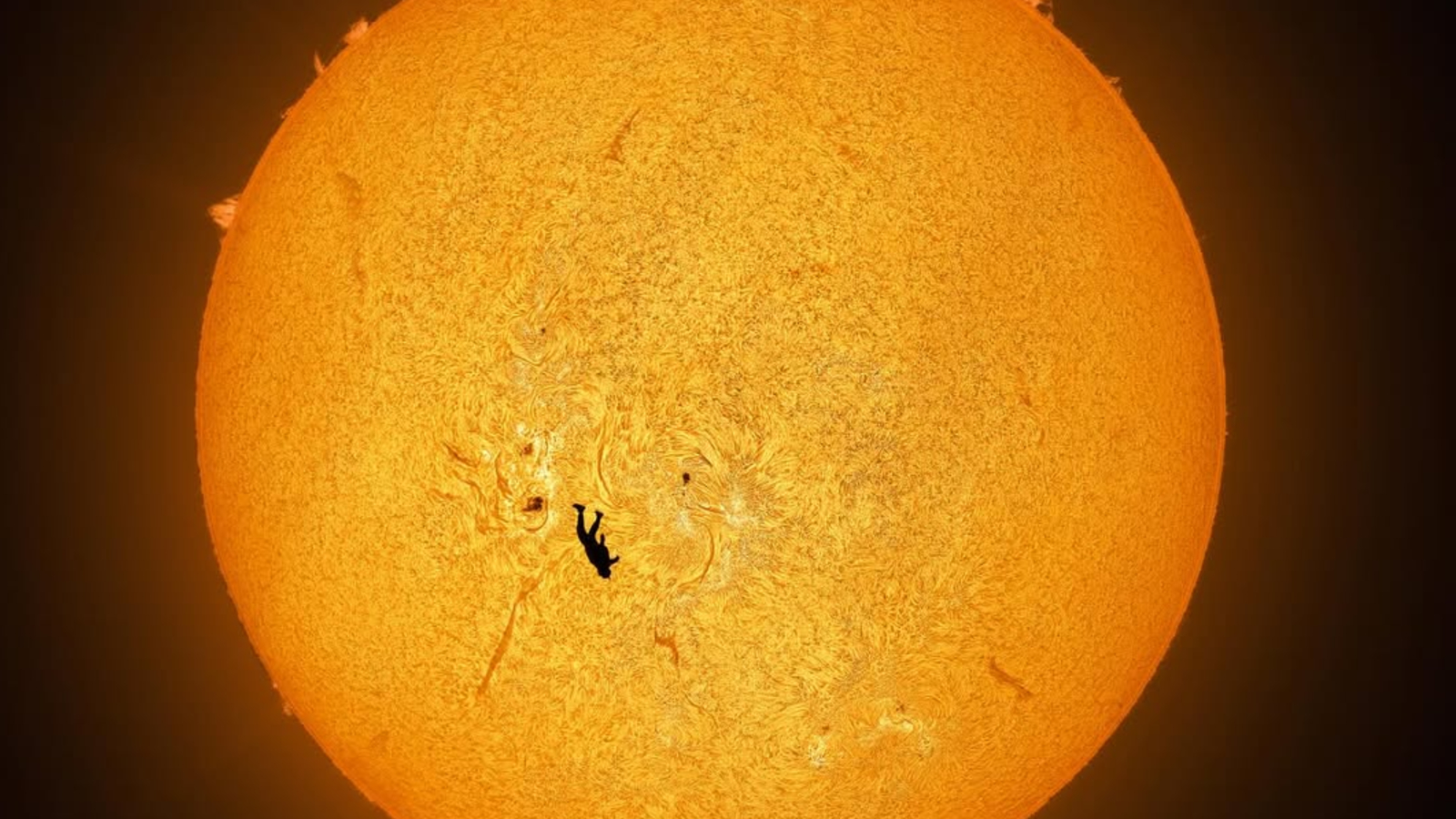Astrophotographer snaps 'absolutely preposterous' photo of skydiver 'falling' past the sun's surface
Astrophotographer Andrew McCarthy has snapped a striking shot of a skydiving YouTuber perfectly aligned with the fiery surface of the sun. The unlikely image, dubbed "The Fall of Icarus," required meticulous planning to pull off.

An astrophotographer has captured a spectacular shot of a falling skydiver perfectly aligned with the fiery surface of the sun, making it seem like the airborne adventurer is tumbling through the vacuum of space in front of our home star.
Andrew McCarthy, an Arizona-based astrophotographer who specializes in photographing the sun, captured the unlikely photo on Saturday (Nov. 8) at around 9 a.m. MST (11 am EST). The shot, dubbed "The Fall of Icarus," required an "absolutely preposterous" level of planning and "might be the first photo of its kind in existence," McCarthy wrote in a post on the social platform X.
The skydiver in the image was the YouTuber and musician Gabriel C. Brown, who jumped from a small propeller-powered craft at an altitude of around 3,500 feet (1,070 meters), around 8,000 feet (2,440 m) from McCarthy's camera. Brown shared several behind-the-scenes photos of the shoot in an Instagram post, including a video of him and McCarthy celebrating the shot.
"You can see the excitement on my face in the videos," McCarthy told Live Science. "Seeing it perfectly captured on my monitors was exhilarating."
The image was captured on the first and only jump of the day, McCarthy added. However, despite weeks of meticulous planning, it took six attempts to properly line up the aircraft with the sun. You can see the exact moment Clarke jumped in a video posted to X by McCarthy (see below).

"It was a narrow field of view, so it took several attempts to line up the shot," McCarthy added. "We only had one shot at the jump as repacking the parachute safely would take too long for another."
The biggest issue the pair faced was that the aircraft they used was a lot harder to reliably track through the sky than they first thought, McCarthy said. "Capturing the sun is something I'm quite familiar with, but this added new challenges."
Get the world’s most fascinating discoveries delivered straight to your inbox.
The moment of the jump, captured in hydrogen alpha light to resolve the sun’s atmosphere.We decided to release the photo in print- both as an up close shot and showing the full disc of the sun, which you can see here: https://t.co/K4DovGV4ni pic.twitter.com/hYHg7rZXdKNovember 13, 2025
McCarthy added that the new photo is comfortably one of the "top 5" he has taken during his career to date.
In the last few months, he has also captured other solar transit photos, including a "once-in-a-lifetime" shot of the International Space Station photobombing a solar flare and a SpaceX rocket appearing to cut through the solar disk.
In the past, he has also snapped an incredible shot of a 1-million-mile-long (1.6 million km) plasma plume erupting from the sun, as well as an ultra-high-definition photo of the lunar surface and a striking image of Mars being eclipsed by the moon.

Harry is a U.K.-based senior staff writer at Live Science. He studied marine biology at the University of Exeter before training to become a journalist. He covers a wide range of topics including space exploration, planetary science, space weather, climate change, animal behavior and paleontology. His recent work on the solar maximum won "best space submission" at the 2024 Aerospace Media Awards and was shortlisted in the "top scoop" category at the NCTJ Awards for Excellence in 2023. He also writes Live Science's weekly Earth from space series.
You must confirm your public display name before commenting
Please logout and then login again, you will then be prompted to enter your display name.
